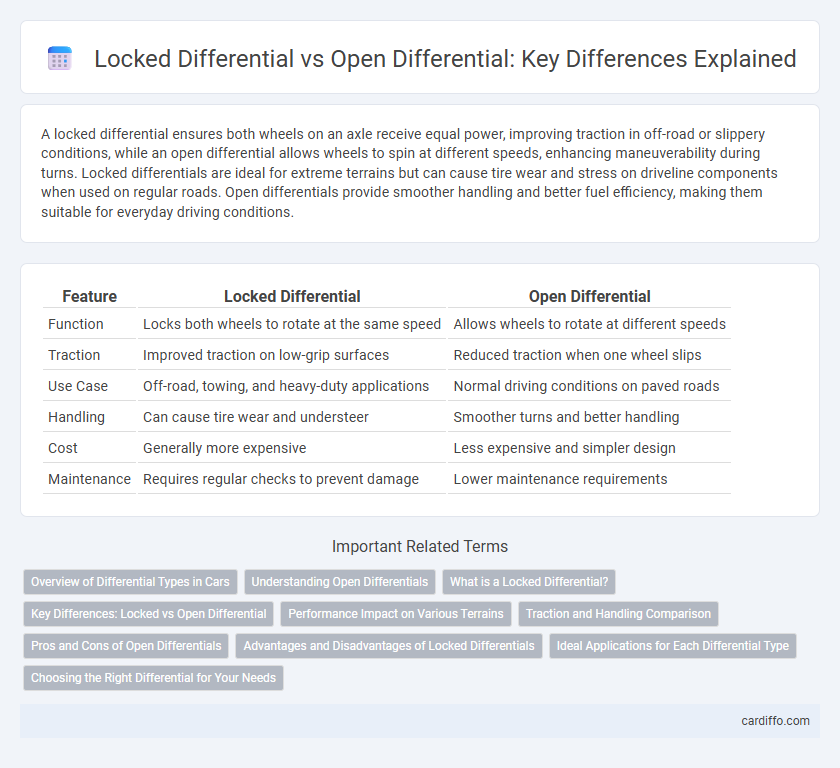A locked differential ensures both wheels on an axle receive equal power, improving traction in off-road or slippery conditions, while an open differential allows wheels to spin at different speeds, enhancing maneuverability during turns. Locked differentials are ideal for extreme terrains but can cause tire wear and stress on driveline components when used on regular roads. Open differentials provide smoother handling and better fuel efficiency, making them suitable for everyday driving conditions.
Table of Comparison
| Feature | Locked Differential | Open Differential |
|---|---|---|
| Function | Locks both wheels to rotate at the same speed | Allows wheels to rotate at different speeds |
| Traction | Improved traction on low-grip surfaces | Reduced traction when one wheel slips |
| Use Case | Off-road, towing, and heavy-duty applications | Normal driving conditions on paved roads |
| Handling | Can cause tire wear and understeer | Smoother turns and better handling |
| Cost | Generally more expensive | Less expensive and simpler design |
| Maintenance | Requires regular checks to prevent damage | Lower maintenance requirements |
Overview of Differential Types in Cars
Locked differentials provide equal torque to both wheels on an axle, improving traction in off-road or slippery conditions by preventing wheel spin. Open differentials allow wheels to rotate at different speeds, essential for smooth cornering and preventing tire wear on paved roads. Understanding these differential types helps optimize vehicle performance based on driving environments and conditions.
Understanding Open Differentials
Open differentials allow wheels to rotate at different speeds, enhancing maneuverability during turns by distributing torque evenly between wheels. These systems are simple, cost-effective, and commonly used in everyday vehicles but may struggle with traction on slippery surfaces. Understanding open differentials is crucial for identifying why a vehicle might lose grip or performance during breakdowns related to wheel slippage.
What is a Locked Differential?
A locked differential is a drivetrain component that forces both wheels on an axle to rotate at the same speed, providing maximum traction on slippery or uneven surfaces. Unlike an open differential, which allows wheels to spin independently, a locked differential prevents wheel slip and improves vehicle control in off-road or low-traction conditions. This mechanism is essential for enhancing stability and power distribution during breakdown recovery or challenging driving environments.
Key Differences: Locked vs Open Differential
A locked differential ensures both wheels on an axle rotate at the same speed, providing maximum traction in off-road or slippery conditions, while an open differential allows wheels to spin at different speeds, improving handling and maneuverability on paved surfaces. Locked differentials are ideal for extreme terrains as they prevent wheel slip but may cause tire wear and steering difficulties. Open differentials enhance fuel efficiency and reduce drivetrain stress but can struggle with traction when one wheel loses grip.
Performance Impact on Various Terrains
A locked differential delivers maximum traction by distributing equal power to both wheels, enhancing performance on slippery or uneven terrains like mud, snow, and rocky surfaces. An open differential allows wheels to spin at different speeds, improving handling and tire wear on paved roads but reducing traction in low-grip conditions. Off-road vehicles benefit from locked differentials for climbing and crawling, while open differentials suit everyday driving with smoother cornering and fuel efficiency.
Traction and Handling Comparison
A locked differential provides equal torque to both wheels, enhancing traction on slippery or uneven surfaces by preventing wheel spin. An open differential allows wheels to rotate at different speeds, improving handling and cornering stability but can result in reduced traction when one wheel loses grip. This trade-off makes locked differentials preferable for off-road and low-traction conditions, while open differentials are ideal for smooth pavement and high-speed vehicle control.
Pros and Cons of Open Differentials
Open differentials offer smooth cornering by allowing each wheel to rotate at different speeds, which enhances drivability on paved roads and reduces tire wear. Their simplicity leads to lower manufacturing costs and easier maintenance compared to locked differentials. However, open differentials struggle with traction on slippery or uneven surfaces, as power is sent to the wheel with the least grip, causing potential vehicle immobilization.
Advantages and Disadvantages of Locked Differentials
Locked differentials provide superior traction on rough or slippery terrain by forcing both wheels on an axle to rotate at the same speed, preventing wheel slip. This advantage enhances vehicle control in off-road conditions but can cause excessive tire wear and increased drivetrain stress on paved roads. Closed or open differentials offer smoother handling and better fuel efficiency by allowing wheels to rotate independently but may struggle with traction in low-grip environments.
Ideal Applications for Each Differential Type
Locked differentials excel in off-road vehicles, heavy-duty trucks, and situations requiring maximum traction, such as slippery or uneven terrains. Open differentials are ideal for everyday passenger cars and light trucks, providing smoother turns and better fuel efficiency on paved roads. Choosing the right differential depends on balancing traction needs with driving conditions and vehicle usage.
Choosing the Right Differential for Your Needs
Choosing the right differential depends on your driving conditions and performance requirements, as locked differentials provide maximum traction by forcing both wheels to rotate at the same speed, ideal for off-road and low-traction environments. Open differentials allow wheels to rotate independently, offering smoother cornering and better handling on paved roads but may struggle in slippery situations. Understanding these distinctions helps optimize vehicle control, ensuring safety and efficiency tailored to specific driving needs.
Locked differential vs open differential Infographic

 cardiffo.com
cardiffo.com